Program Planning & Evaluation in Health Care: Annotated Bibliography
VerifiedAdded on 2023/06/07
|10
|2870
|471
Annotated Bibliography
AI Summary
This annotated bibliography provides a review of several research papers related to program planning and evaluation in healthcare. The bibliography includes summaries of studies focusing on barriers to mental health service improvement in low-income countries, the impact of the 4-hour rule on emergency department overcrowding and mortality in Western Australia, transitional care needs of vulnerable seniors, methods for evaluating and planning intensive care units, and patient engagement in hospital health service improvement. Each annotation summarizes the study's objectives, methods, findings, and limitations, offering insights into various aspects of healthcare planning and evaluation. The papers highlight the importance of addressing funding shortages, improving care transitions, optimizing resource utilization, and involving patients in service improvement initiatives. The assignment is available on Desklib, which is a platform that provides various AI based study tools for students.
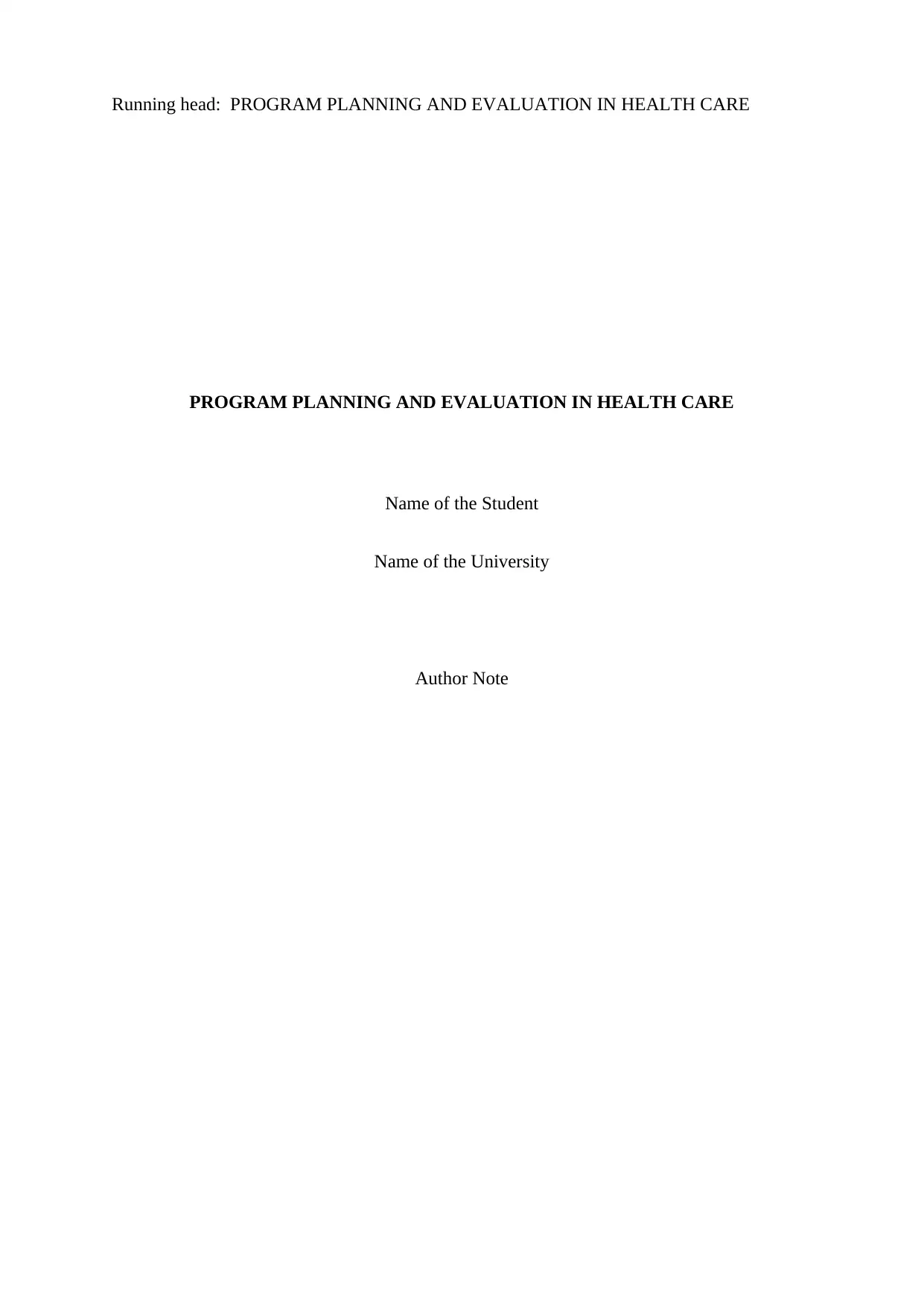
Running head: PROGRAM PLANNING AND EVALUATION IN HEALTH CARE
PROGRAM PLANNING AND EVALUATION IN HEALTH CARE
Name of the Student
Name of the University
Author Note
PROGRAM PLANNING AND EVALUATION IN HEALTH CARE
Name of the Student
Name of the University
Author Note
Paraphrase This Document
Need a fresh take? Get an instant paraphrase of this document with our AI Paraphraser
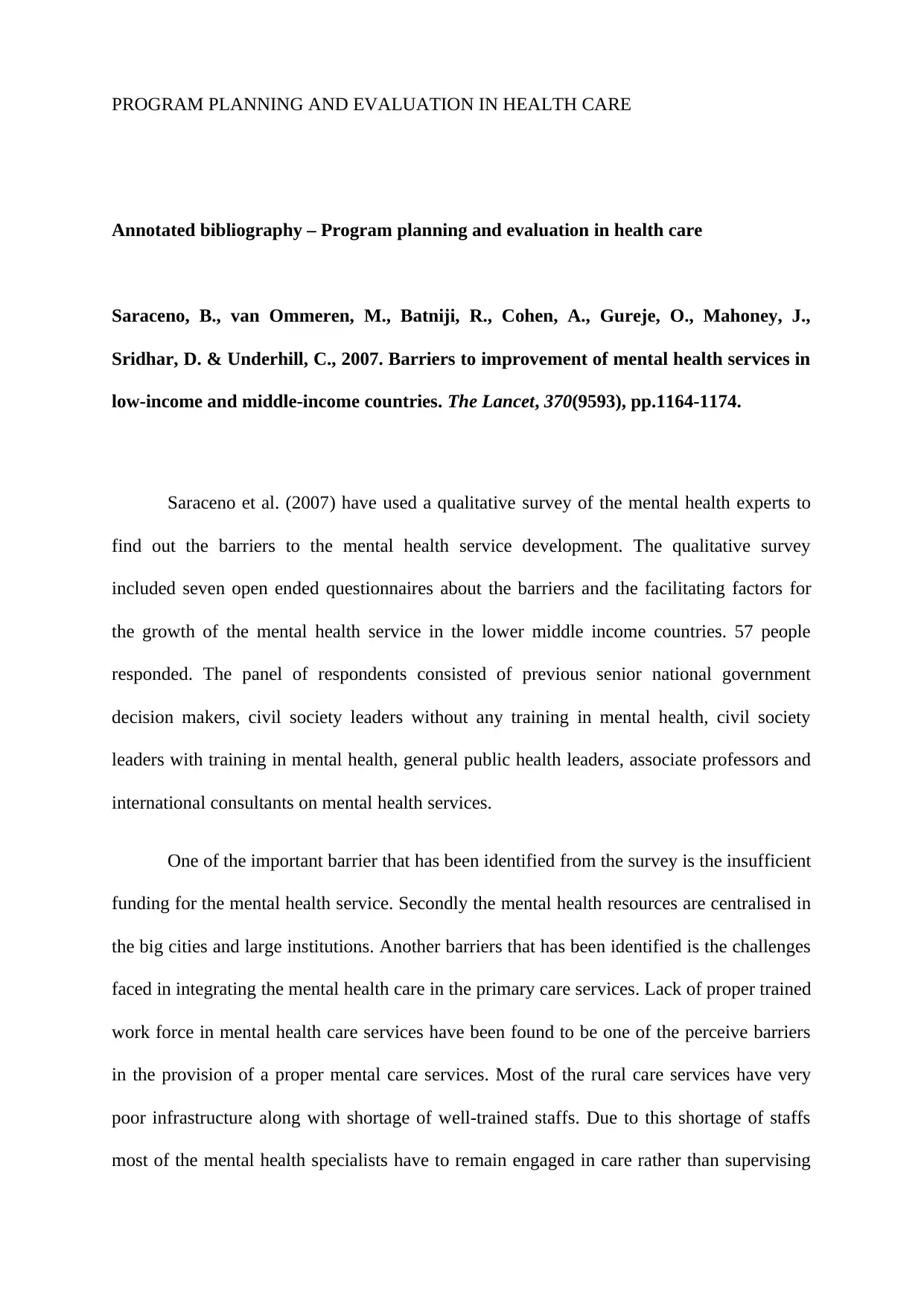
PROGRAM PLANNING AND EVALUATION IN HEALTH CARE
Annotated bibliography – Program planning and evaluation in health care
Saraceno, B., van Ommeren, M., Batniji, R., Cohen, A., Gureje, O., Mahoney, J.,
Sridhar, D. & Underhill, C., 2007. Barriers to improvement of mental health services in
low-income and middle-income countries. The Lancet, 370(9593), pp.1164-1174.
Saraceno et al. (2007) have used a qualitative survey of the mental health experts to
find out the barriers to the mental health service development. The qualitative survey
included seven open ended questionnaires about the barriers and the facilitating factors for
the growth of the mental health service in the lower middle income countries. 57 people
responded. The panel of respondents consisted of previous senior national government
decision makers, civil society leaders without any training in mental health, civil society
leaders with training in mental health, general public health leaders, associate professors and
international consultants on mental health services.
One of the important barrier that has been identified from the survey is the insufficient
funding for the mental health service. Secondly the mental health resources are centralised in
the big cities and large institutions. Another barriers that has been identified is the challenges
faced in integrating the mental health care in the primary care services. Lack of proper trained
work force in mental health care services have been found to be one of the perceive barriers
in the provision of a proper mental care services. Most of the rural care services have very
poor infrastructure along with shortage of well-trained staffs. Due to this shortage of staffs
most of the mental health specialists have to remain engaged in care rather than supervising
Annotated bibliography – Program planning and evaluation in health care
Saraceno, B., van Ommeren, M., Batniji, R., Cohen, A., Gureje, O., Mahoney, J.,
Sridhar, D. & Underhill, C., 2007. Barriers to improvement of mental health services in
low-income and middle-income countries. The Lancet, 370(9593), pp.1164-1174.
Saraceno et al. (2007) have used a qualitative survey of the mental health experts to
find out the barriers to the mental health service development. The qualitative survey
included seven open ended questionnaires about the barriers and the facilitating factors for
the growth of the mental health service in the lower middle income countries. 57 people
responded. The panel of respondents consisted of previous senior national government
decision makers, civil society leaders without any training in mental health, civil society
leaders with training in mental health, general public health leaders, associate professors and
international consultants on mental health services.
One of the important barrier that has been identified from the survey is the insufficient
funding for the mental health service. Secondly the mental health resources are centralised in
the big cities and large institutions. Another barriers that has been identified is the challenges
faced in integrating the mental health care in the primary care services. Lack of proper trained
work force in mental health care services have been found to be one of the perceive barriers
in the provision of a proper mental care services. Most of the rural care services have very
poor infrastructure along with shortage of well-trained staffs. Due to this shortage of staffs
most of the mental health specialists have to remain engaged in care rather than supervising
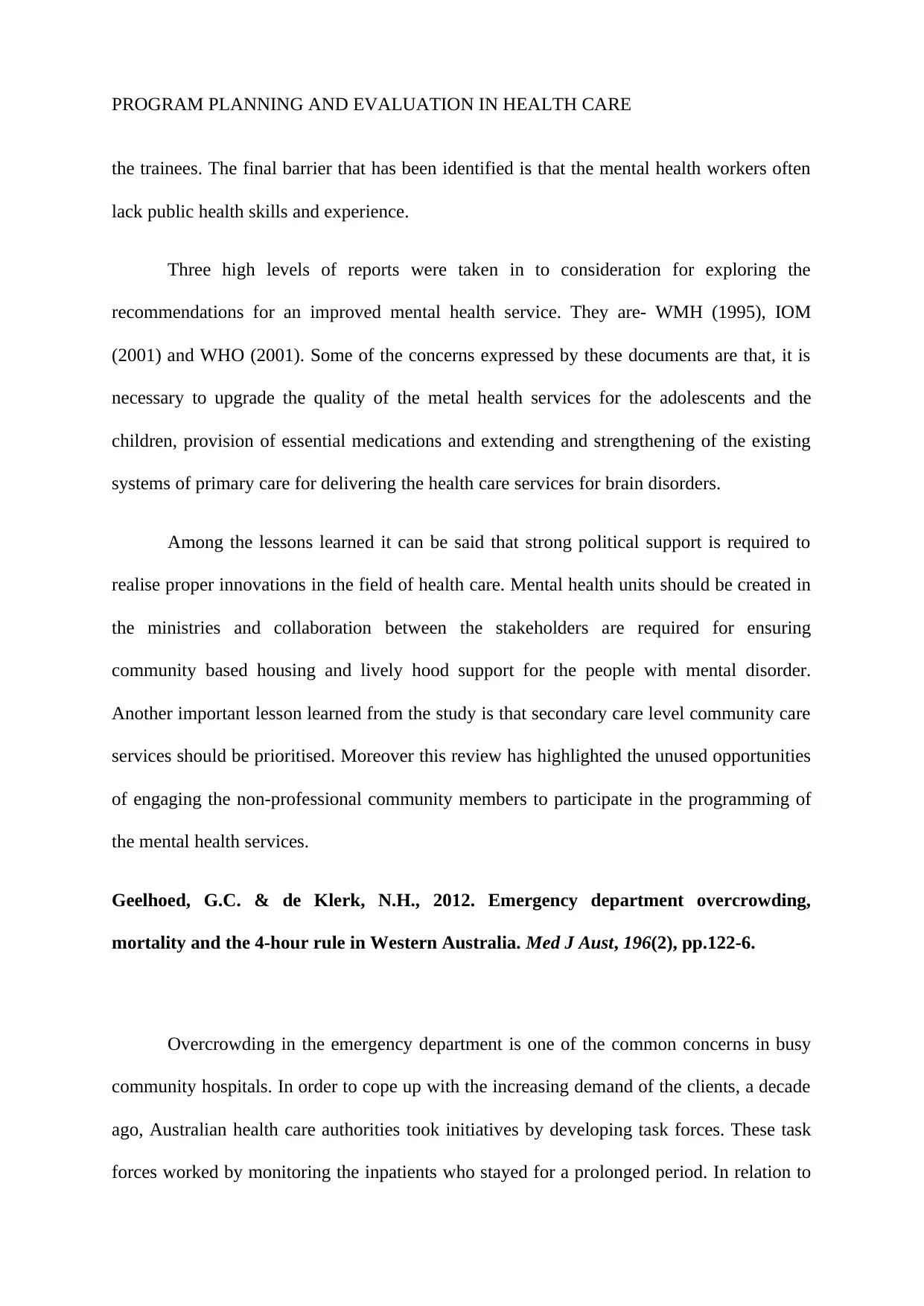
PROGRAM PLANNING AND EVALUATION IN HEALTH CARE
the trainees. The final barrier that has been identified is that the mental health workers often
lack public health skills and experience.
Three high levels of reports were taken in to consideration for exploring the
recommendations for an improved mental health service. They are- WMH (1995), IOM
(2001) and WHO (2001). Some of the concerns expressed by these documents are that, it is
necessary to upgrade the quality of the metal health services for the adolescents and the
children, provision of essential medications and extending and strengthening of the existing
systems of primary care for delivering the health care services for brain disorders.
Among the lessons learned it can be said that strong political support is required to
realise proper innovations in the field of health care. Mental health units should be created in
the ministries and collaboration between the stakeholders are required for ensuring
community based housing and lively hood support for the people with mental disorder.
Another important lesson learned from the study is that secondary care level community care
services should be prioritised. Moreover this review has highlighted the unused opportunities
of engaging the non-professional community members to participate in the programming of
the mental health services.
Geelhoed, G.C. & de Klerk, N.H., 2012. Emergency department overcrowding,
mortality and the 4-hour rule in Western Australia. Med J Aust, 196(2), pp.122-6.
Overcrowding in the emergency department is one of the common concerns in busy
community hospitals. In order to cope up with the increasing demand of the clients, a decade
ago, Australian health care authorities took initiatives by developing task forces. These task
forces worked by monitoring the inpatients who stayed for a prolonged period. In relation to
the trainees. The final barrier that has been identified is that the mental health workers often
lack public health skills and experience.
Three high levels of reports were taken in to consideration for exploring the
recommendations for an improved mental health service. They are- WMH (1995), IOM
(2001) and WHO (2001). Some of the concerns expressed by these documents are that, it is
necessary to upgrade the quality of the metal health services for the adolescents and the
children, provision of essential medications and extending and strengthening of the existing
systems of primary care for delivering the health care services for brain disorders.
Among the lessons learned it can be said that strong political support is required to
realise proper innovations in the field of health care. Mental health units should be created in
the ministries and collaboration between the stakeholders are required for ensuring
community based housing and lively hood support for the people with mental disorder.
Another important lesson learned from the study is that secondary care level community care
services should be prioritised. Moreover this review has highlighted the unused opportunities
of engaging the non-professional community members to participate in the programming of
the mental health services.
Geelhoed, G.C. & de Klerk, N.H., 2012. Emergency department overcrowding,
mortality and the 4-hour rule in Western Australia. Med J Aust, 196(2), pp.122-6.
Overcrowding in the emergency department is one of the common concerns in busy
community hospitals. In order to cope up with the increasing demand of the clients, a decade
ago, Australian health care authorities took initiatives by developing task forces. These task
forces worked by monitoring the inpatients who stayed for a prolonged period. In relation to
⊘ This is a preview!⊘
Do you want full access?
Subscribe today to unlock all pages.

Trusted by 1+ million students worldwide
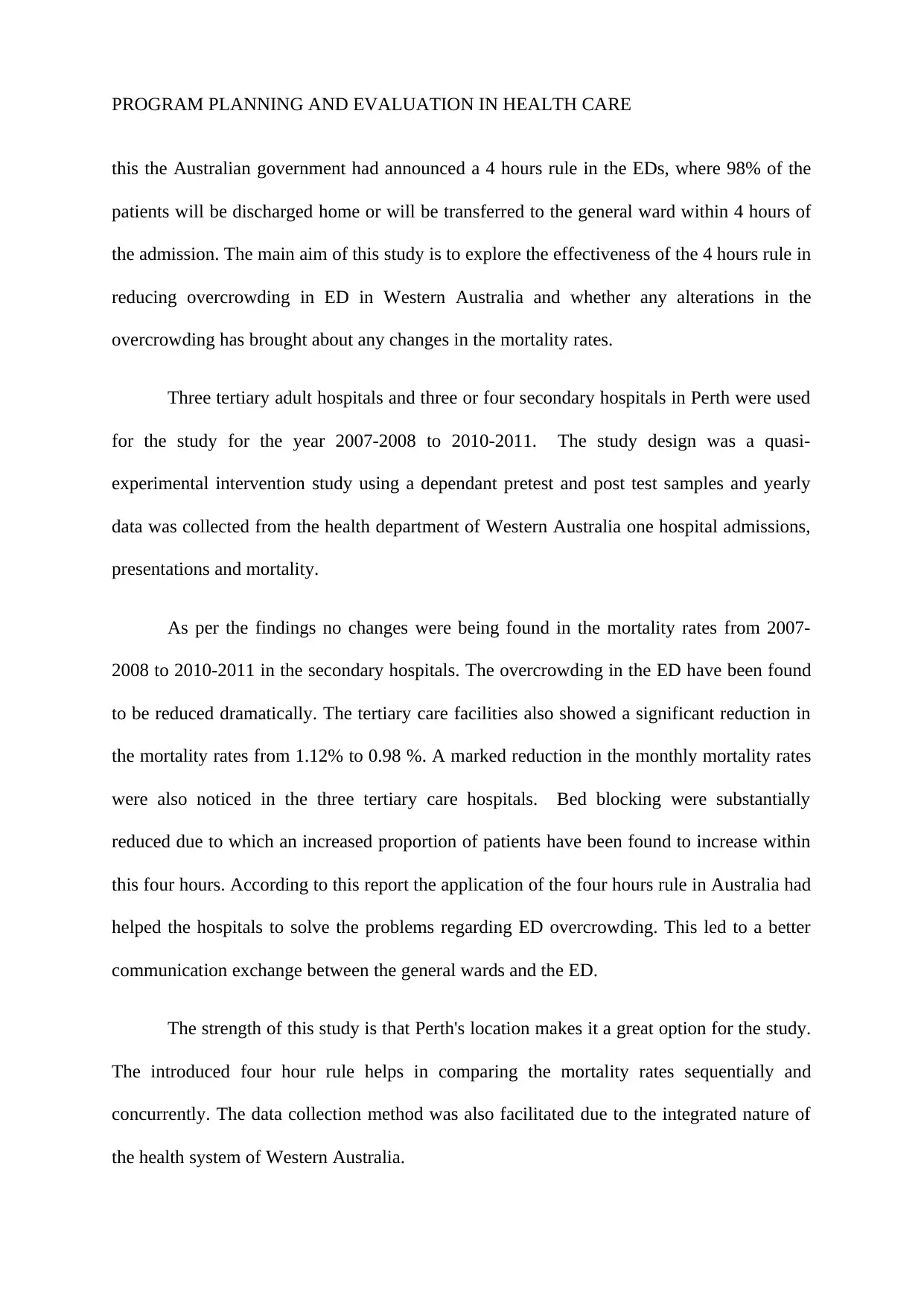
PROGRAM PLANNING AND EVALUATION IN HEALTH CARE
this the Australian government had announced a 4 hours rule in the EDs, where 98% of the
patients will be discharged home or will be transferred to the general ward within 4 hours of
the admission. The main aim of this study is to explore the effectiveness of the 4 hours rule in
reducing overcrowding in ED in Western Australia and whether any alterations in the
overcrowding has brought about any changes in the mortality rates.
Three tertiary adult hospitals and three or four secondary hospitals in Perth were used
for the study for the year 2007-2008 to 2010-2011. The study design was a quasi-
experimental intervention study using a dependant pretest and post test samples and yearly
data was collected from the health department of Western Australia one hospital admissions,
presentations and mortality.
As per the findings no changes were being found in the mortality rates from 2007-
2008 to 2010-2011 in the secondary hospitals. The overcrowding in the ED have been found
to be reduced dramatically. The tertiary care facilities also showed a significant reduction in
the mortality rates from 1.12% to 0.98 %. A marked reduction in the monthly mortality rates
were also noticed in the three tertiary care hospitals. Bed blocking were substantially
reduced due to which an increased proportion of patients have been found to increase within
this four hours. According to this report the application of the four hours rule in Australia had
helped the hospitals to solve the problems regarding ED overcrowding. This led to a better
communication exchange between the general wards and the ED.
The strength of this study is that Perth's location makes it a great option for the study.
The introduced four hour rule helps in comparing the mortality rates sequentially and
concurrently. The data collection method was also facilitated due to the integrated nature of
the health system of Western Australia.
this the Australian government had announced a 4 hours rule in the EDs, where 98% of the
patients will be discharged home or will be transferred to the general ward within 4 hours of
the admission. The main aim of this study is to explore the effectiveness of the 4 hours rule in
reducing overcrowding in ED in Western Australia and whether any alterations in the
overcrowding has brought about any changes in the mortality rates.
Three tertiary adult hospitals and three or four secondary hospitals in Perth were used
for the study for the year 2007-2008 to 2010-2011. The study design was a quasi-
experimental intervention study using a dependant pretest and post test samples and yearly
data was collected from the health department of Western Australia one hospital admissions,
presentations and mortality.
As per the findings no changes were being found in the mortality rates from 2007-
2008 to 2010-2011 in the secondary hospitals. The overcrowding in the ED have been found
to be reduced dramatically. The tertiary care facilities also showed a significant reduction in
the mortality rates from 1.12% to 0.98 %. A marked reduction in the monthly mortality rates
were also noticed in the three tertiary care hospitals. Bed blocking were substantially
reduced due to which an increased proportion of patients have been found to increase within
this four hours. According to this report the application of the four hours rule in Australia had
helped the hospitals to solve the problems regarding ED overcrowding. This led to a better
communication exchange between the general wards and the ED.
The strength of this study is that Perth's location makes it a great option for the study.
The introduced four hour rule helps in comparing the mortality rates sequentially and
concurrently. The data collection method was also facilitated due to the integrated nature of
the health system of Western Australia.
Paraphrase This Document
Need a fresh take? Get an instant paraphrase of this document with our AI Paraphraser
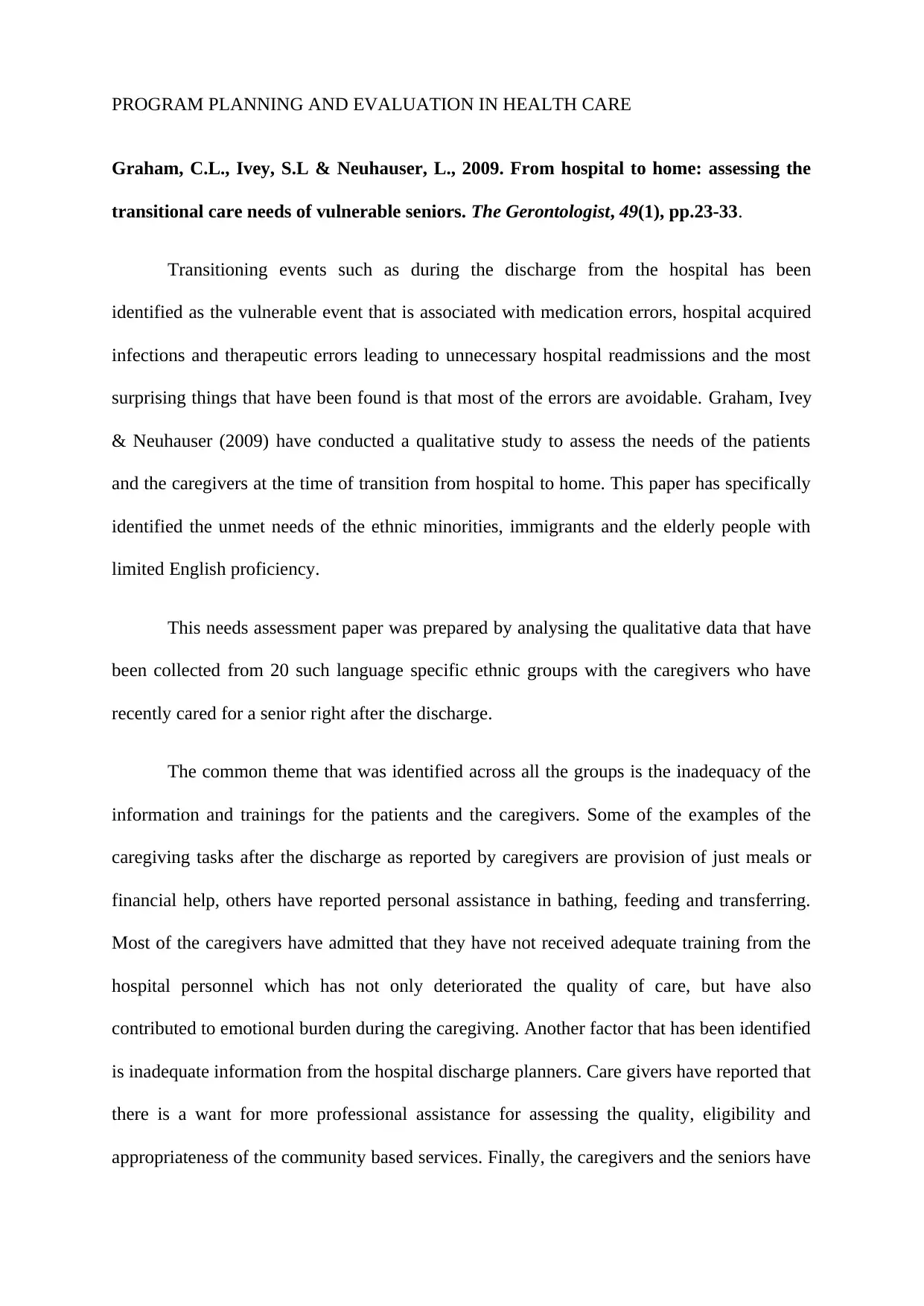
PROGRAM PLANNING AND EVALUATION IN HEALTH CARE
Graham, C.L., Ivey, S.L & Neuhauser, L., 2009. From hospital to home: assessing the
transitional care needs of vulnerable seniors. The Gerontologist, 49(1), pp.23-33.
Transitioning events such as during the discharge from the hospital has been
identified as the vulnerable event that is associated with medication errors, hospital acquired
infections and therapeutic errors leading to unnecessary hospital readmissions and the most
surprising things that have been found is that most of the errors are avoidable. Graham, Ivey
& Neuhauser (2009) have conducted a qualitative study to assess the needs of the patients
and the caregivers at the time of transition from hospital to home. This paper has specifically
identified the unmet needs of the ethnic minorities, immigrants and the elderly people with
limited English proficiency.
This needs assessment paper was prepared by analysing the qualitative data that have
been collected from 20 such language specific ethnic groups with the caregivers who have
recently cared for a senior right after the discharge.
The common theme that was identified across all the groups is the inadequacy of the
information and trainings for the patients and the caregivers. Some of the examples of the
caregiving tasks after the discharge as reported by caregivers are provision of just meals or
financial help, others have reported personal assistance in bathing, feeding and transferring.
Most of the caregivers have admitted that they have not received adequate training from the
hospital personnel which has not only deteriorated the quality of care, but have also
contributed to emotional burden during the caregiving. Another factor that has been identified
is inadequate information from the hospital discharge planners. Care givers have reported that
there is a want for more professional assistance for assessing the quality, eligibility and
appropriateness of the community based services. Finally, the caregivers and the seniors have
Graham, C.L., Ivey, S.L & Neuhauser, L., 2009. From hospital to home: assessing the
transitional care needs of vulnerable seniors. The Gerontologist, 49(1), pp.23-33.
Transitioning events such as during the discharge from the hospital has been
identified as the vulnerable event that is associated with medication errors, hospital acquired
infections and therapeutic errors leading to unnecessary hospital readmissions and the most
surprising things that have been found is that most of the errors are avoidable. Graham, Ivey
& Neuhauser (2009) have conducted a qualitative study to assess the needs of the patients
and the caregivers at the time of transition from hospital to home. This paper has specifically
identified the unmet needs of the ethnic minorities, immigrants and the elderly people with
limited English proficiency.
This needs assessment paper was prepared by analysing the qualitative data that have
been collected from 20 such language specific ethnic groups with the caregivers who have
recently cared for a senior right after the discharge.
The common theme that was identified across all the groups is the inadequacy of the
information and trainings for the patients and the caregivers. Some of the examples of the
caregiving tasks after the discharge as reported by caregivers are provision of just meals or
financial help, others have reported personal assistance in bathing, feeding and transferring.
Most of the caregivers have admitted that they have not received adequate training from the
hospital personnel which has not only deteriorated the quality of care, but have also
contributed to emotional burden during the caregiving. Another factor that has been identified
is inadequate information from the hospital discharge planners. Care givers have reported that
there is a want for more professional assistance for assessing the quality, eligibility and
appropriateness of the community based services. Finally, the caregivers and the seniors have
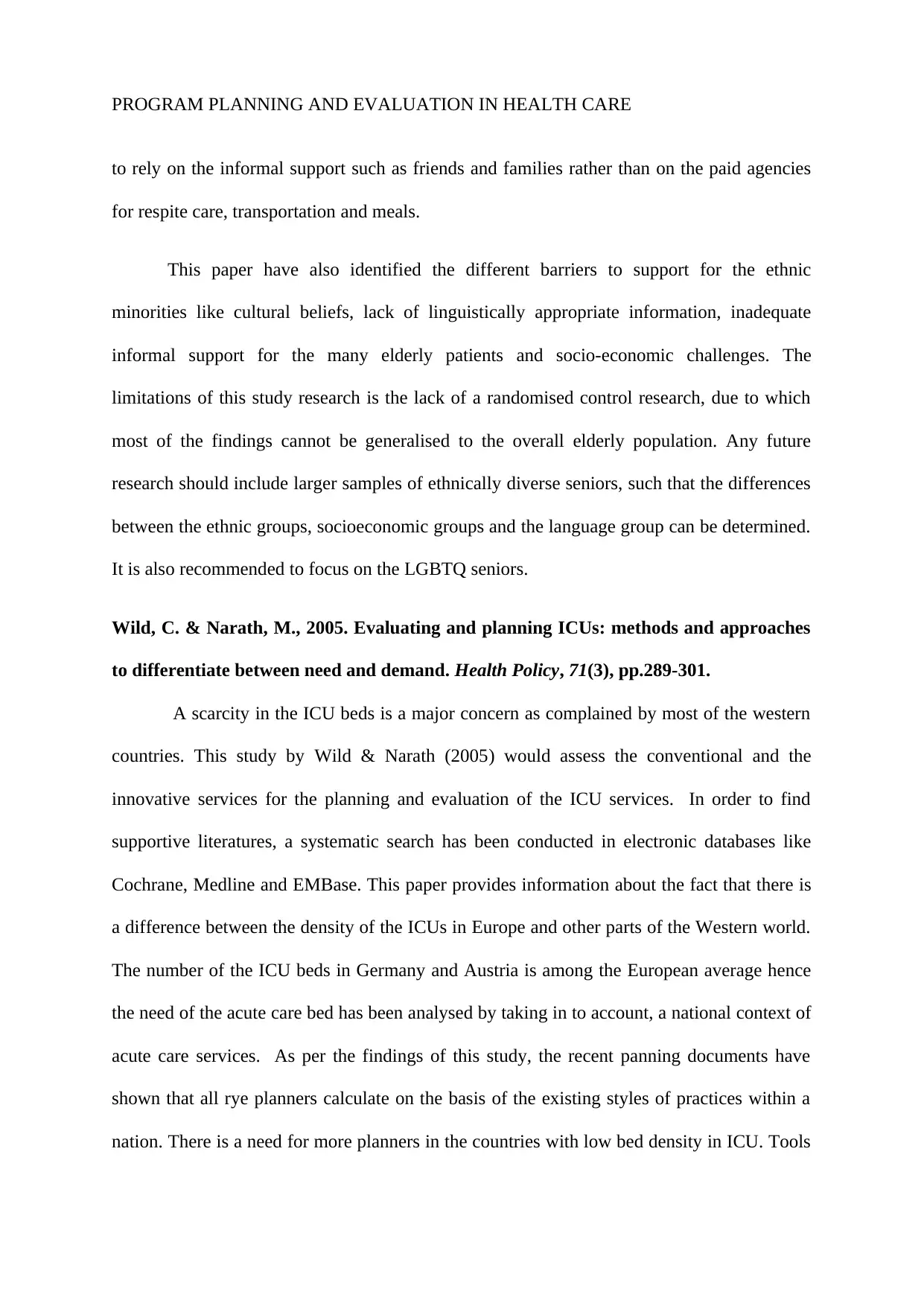
PROGRAM PLANNING AND EVALUATION IN HEALTH CARE
to rely on the informal support such as friends and families rather than on the paid agencies
for respite care, transportation and meals.
This paper have also identified the different barriers to support for the ethnic
minorities like cultural beliefs, lack of linguistically appropriate information, inadequate
informal support for the many elderly patients and socio-economic challenges. The
limitations of this study research is the lack of a randomised control research, due to which
most of the findings cannot be generalised to the overall elderly population. Any future
research should include larger samples of ethnically diverse seniors, such that the differences
between the ethnic groups, socioeconomic groups and the language group can be determined.
It is also recommended to focus on the LGBTQ seniors.
Wild, C. & Narath, M., 2005. Evaluating and planning ICUs: methods and approaches
to differentiate between need and demand. Health Policy, 71(3), pp.289-301.
A scarcity in the ICU beds is a major concern as complained by most of the western
countries. This study by Wild & Narath (2005) would assess the conventional and the
innovative services for the planning and evaluation of the ICU services. In order to find
supportive literatures, a systematic search has been conducted in electronic databases like
Cochrane, Medline and EMBase. This paper provides information about the fact that there is
a difference between the density of the ICUs in Europe and other parts of the Western world.
The number of the ICU beds in Germany and Austria is among the European average hence
the need of the acute care bed has been analysed by taking in to account, a national context of
acute care services. As per the findings of this study, the recent panning documents have
shown that all rye planners calculate on the basis of the existing styles of practices within a
nation. There is a need for more planners in the countries with low bed density in ICU. Tools
to rely on the informal support such as friends and families rather than on the paid agencies
for respite care, transportation and meals.
This paper have also identified the different barriers to support for the ethnic
minorities like cultural beliefs, lack of linguistically appropriate information, inadequate
informal support for the many elderly patients and socio-economic challenges. The
limitations of this study research is the lack of a randomised control research, due to which
most of the findings cannot be generalised to the overall elderly population. Any future
research should include larger samples of ethnically diverse seniors, such that the differences
between the ethnic groups, socioeconomic groups and the language group can be determined.
It is also recommended to focus on the LGBTQ seniors.
Wild, C. & Narath, M., 2005. Evaluating and planning ICUs: methods and approaches
to differentiate between need and demand. Health Policy, 71(3), pp.289-301.
A scarcity in the ICU beds is a major concern as complained by most of the western
countries. This study by Wild & Narath (2005) would assess the conventional and the
innovative services for the planning and evaluation of the ICU services. In order to find
supportive literatures, a systematic search has been conducted in electronic databases like
Cochrane, Medline and EMBase. This paper provides information about the fact that there is
a difference between the density of the ICUs in Europe and other parts of the Western world.
The number of the ICU beds in Germany and Austria is among the European average hence
the need of the acute care bed has been analysed by taking in to account, a national context of
acute care services. As per the findings of this study, the recent panning documents have
shown that all rye planners calculate on the basis of the existing styles of practices within a
nation. There is a need for more planners in the countries with low bed density in ICU. Tools
⊘ This is a preview!⊘
Do you want full access?
Subscribe today to unlock all pages.

Trusted by 1+ million students worldwide
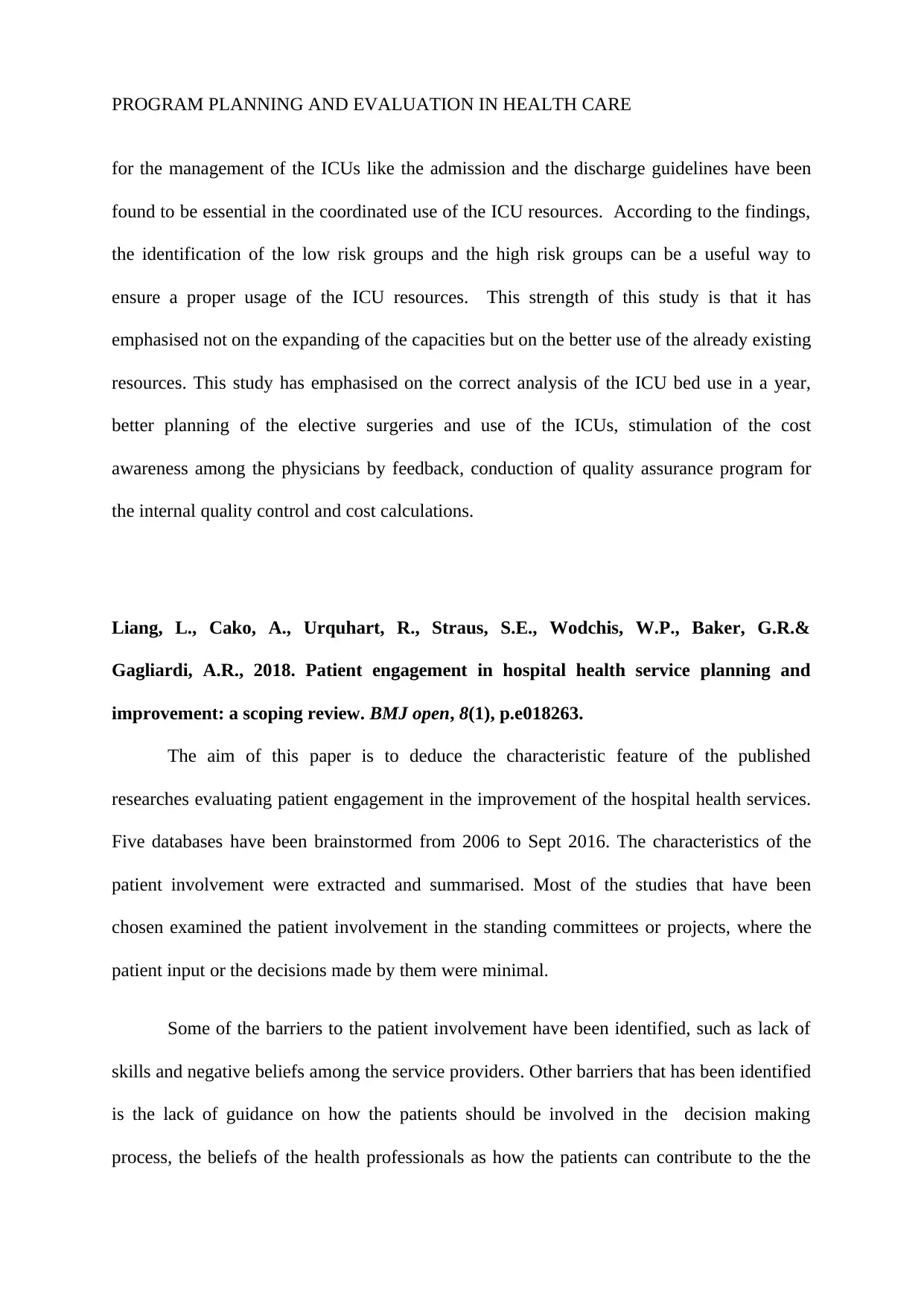
PROGRAM PLANNING AND EVALUATION IN HEALTH CARE
for the management of the ICUs like the admission and the discharge guidelines have been
found to be essential in the coordinated use of the ICU resources. According to the findings,
the identification of the low risk groups and the high risk groups can be a useful way to
ensure a proper usage of the ICU resources. This strength of this study is that it has
emphasised not on the expanding of the capacities but on the better use of the already existing
resources. This study has emphasised on the correct analysis of the ICU bed use in a year,
better planning of the elective surgeries and use of the ICUs, stimulation of the cost
awareness among the physicians by feedback, conduction of quality assurance program for
the internal quality control and cost calculations.
Liang, L., Cako, A., Urquhart, R., Straus, S.E., Wodchis, W.P., Baker, G.R.&
Gagliardi, A.R., 2018. Patient engagement in hospital health service planning and
improvement: a scoping review. BMJ open, 8(1), p.e018263.
The aim of this paper is to deduce the characteristic feature of the published
researches evaluating patient engagement in the improvement of the hospital health services.
Five databases have been brainstormed from 2006 to Sept 2016. The characteristics of the
patient involvement were extracted and summarised. Most of the studies that have been
chosen examined the patient involvement in the standing committees or projects, where the
patient input or the decisions made by them were minimal.
Some of the barriers to the patient involvement have been identified, such as lack of
skills and negative beliefs among the service providers. Other barriers that has been identified
is the lack of guidance on how the patients should be involved in the decision making
process, the beliefs of the health professionals as how the patients can contribute to the the
for the management of the ICUs like the admission and the discharge guidelines have been
found to be essential in the coordinated use of the ICU resources. According to the findings,
the identification of the low risk groups and the high risk groups can be a useful way to
ensure a proper usage of the ICU resources. This strength of this study is that it has
emphasised not on the expanding of the capacities but on the better use of the already existing
resources. This study has emphasised on the correct analysis of the ICU bed use in a year,
better planning of the elective surgeries and use of the ICUs, stimulation of the cost
awareness among the physicians by feedback, conduction of quality assurance program for
the internal quality control and cost calculations.
Liang, L., Cako, A., Urquhart, R., Straus, S.E., Wodchis, W.P., Baker, G.R.&
Gagliardi, A.R., 2018. Patient engagement in hospital health service planning and
improvement: a scoping review. BMJ open, 8(1), p.e018263.
The aim of this paper is to deduce the characteristic feature of the published
researches evaluating patient engagement in the improvement of the hospital health services.
Five databases have been brainstormed from 2006 to Sept 2016. The characteristics of the
patient involvement were extracted and summarised. Most of the studies that have been
chosen examined the patient involvement in the standing committees or projects, where the
patient input or the decisions made by them were minimal.
Some of the barriers to the patient involvement have been identified, such as lack of
skills and negative beliefs among the service providers. Other barriers that has been identified
is the lack of guidance on how the patients should be involved in the decision making
process, the beliefs of the health professionals as how the patients can contribute to the the
Paraphrase This Document
Need a fresh take? Get an instant paraphrase of this document with our AI Paraphraser
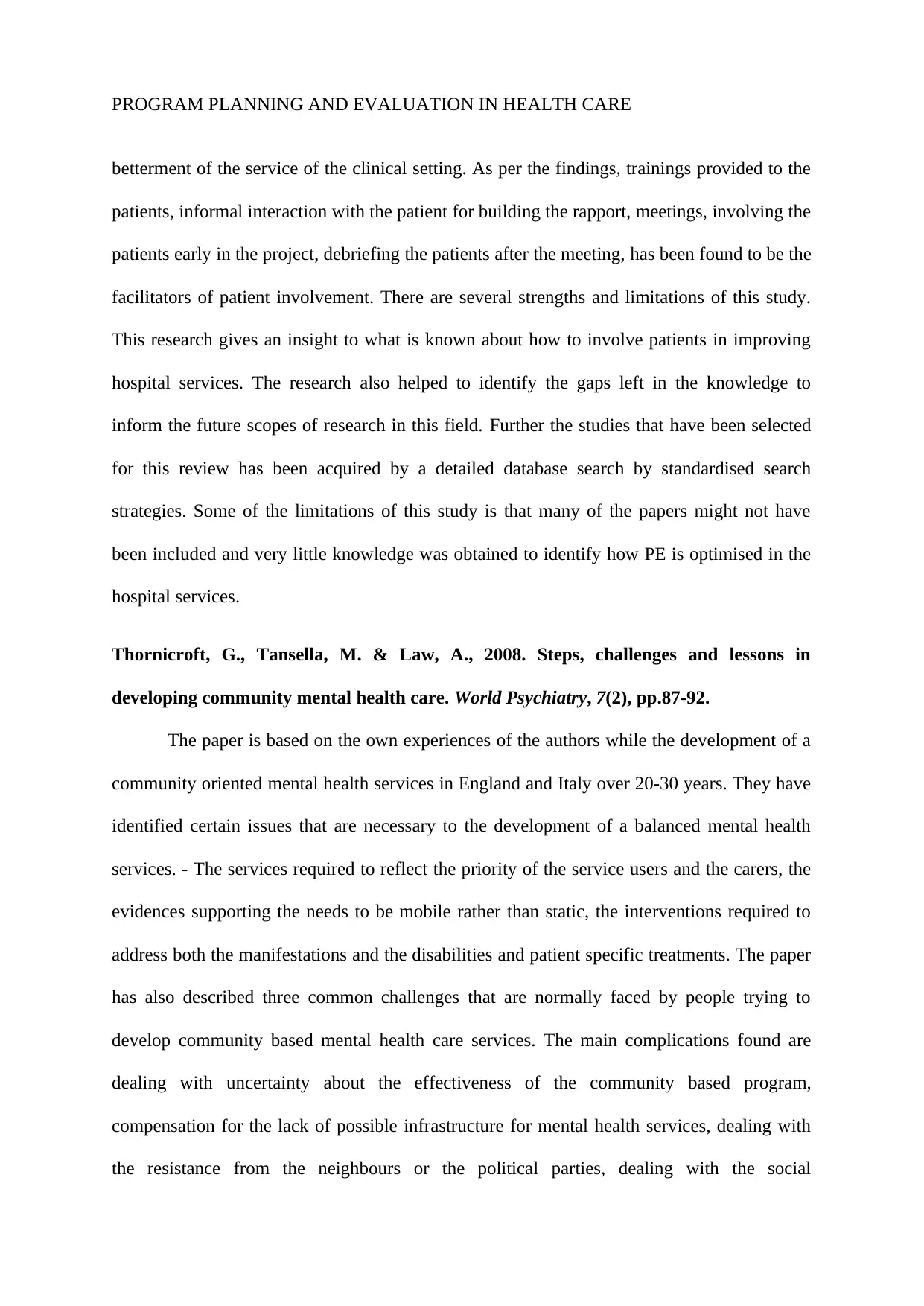
PROGRAM PLANNING AND EVALUATION IN HEALTH CARE
betterment of the service of the clinical setting. As per the findings, trainings provided to the
patients, informal interaction with the patient for building the rapport, meetings, involving the
patients early in the project, debriefing the patients after the meeting, has been found to be the
facilitators of patient involvement. There are several strengths and limitations of this study.
This research gives an insight to what is known about how to involve patients in improving
hospital services. The research also helped to identify the gaps left in the knowledge to
inform the future scopes of research in this field. Further the studies that have been selected
for this review has been acquired by a detailed database search by standardised search
strategies. Some of the limitations of this study is that many of the papers might not have
been included and very little knowledge was obtained to identify how PE is optimised in the
hospital services.
Thornicroft, G., Tansella, M. & Law, A., 2008. Steps, challenges and lessons in
developing community mental health care. World Psychiatry, 7(2), pp.87-92.
The paper is based on the own experiences of the authors while the development of a
community oriented mental health services in England and Italy over 20-30 years. They have
identified certain issues that are necessary to the development of a balanced mental health
services. - The services required to reflect the priority of the service users and the carers, the
evidences supporting the needs to be mobile rather than static, the interventions required to
address both the manifestations and the disabilities and patient specific treatments. The paper
has also described three common challenges that are normally faced by people trying to
develop community based mental health care services. The main complications found are
dealing with uncertainty about the effectiveness of the community based program,
compensation for the lack of possible infrastructure for mental health services, dealing with
the resistance from the neighbours or the political parties, dealing with the social
betterment of the service of the clinical setting. As per the findings, trainings provided to the
patients, informal interaction with the patient for building the rapport, meetings, involving the
patients early in the project, debriefing the patients after the meeting, has been found to be the
facilitators of patient involvement. There are several strengths and limitations of this study.
This research gives an insight to what is known about how to involve patients in improving
hospital services. The research also helped to identify the gaps left in the knowledge to
inform the future scopes of research in this field. Further the studies that have been selected
for this review has been acquired by a detailed database search by standardised search
strategies. Some of the limitations of this study is that many of the papers might not have
been included and very little knowledge was obtained to identify how PE is optimised in the
hospital services.
Thornicroft, G., Tansella, M. & Law, A., 2008. Steps, challenges and lessons in
developing community mental health care. World Psychiatry, 7(2), pp.87-92.
The paper is based on the own experiences of the authors while the development of a
community oriented mental health services in England and Italy over 20-30 years. They have
identified certain issues that are necessary to the development of a balanced mental health
services. - The services required to reflect the priority of the service users and the carers, the
evidences supporting the needs to be mobile rather than static, the interventions required to
address both the manifestations and the disabilities and patient specific treatments. The paper
has also described three common challenges that are normally faced by people trying to
develop community based mental health care services. The main complications found are
dealing with uncertainty about the effectiveness of the community based program,
compensation for the lack of possible infrastructure for mental health services, dealing with
the resistance from the neighbours or the political parties, dealing with the social
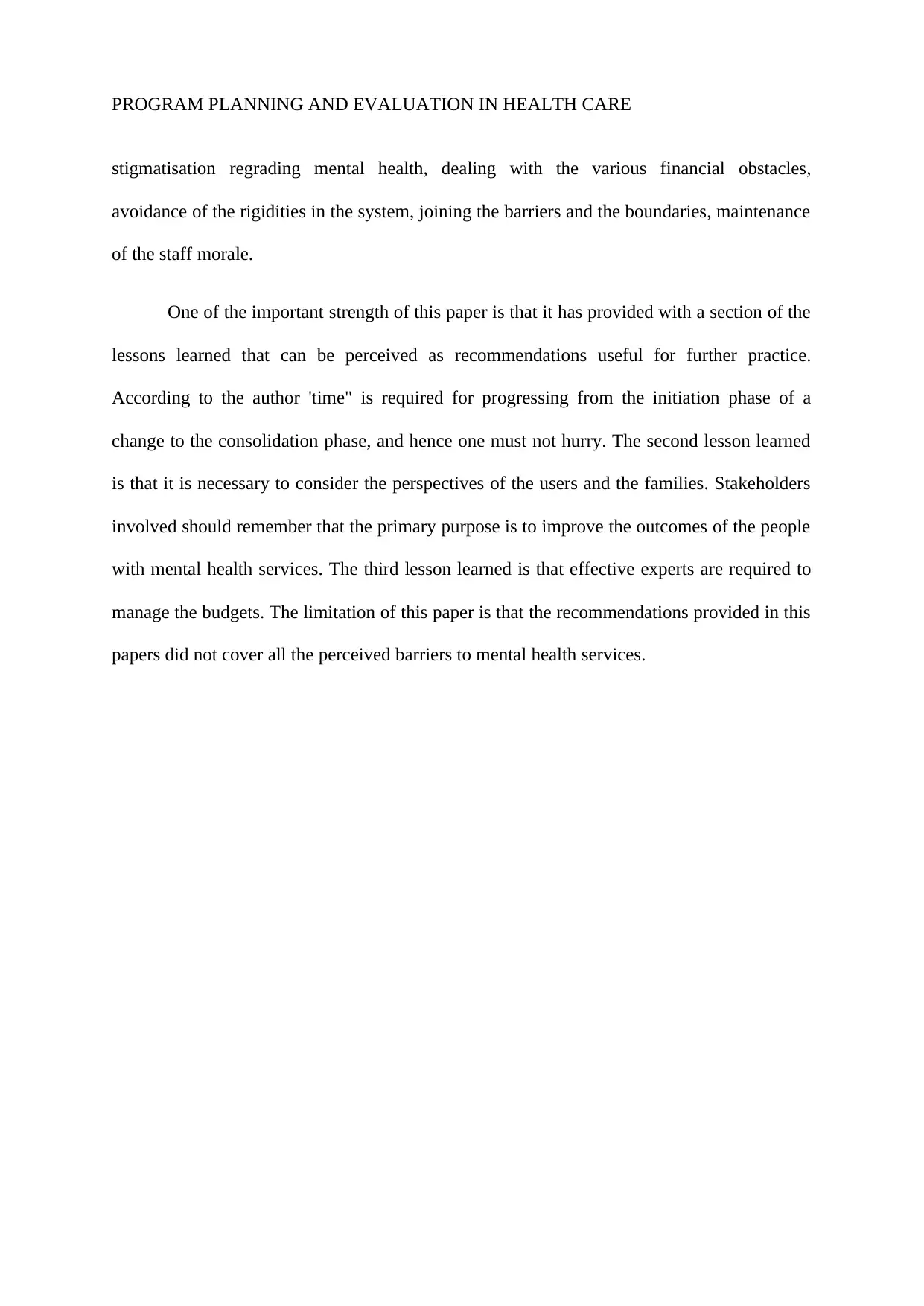
PROGRAM PLANNING AND EVALUATION IN HEALTH CARE
stigmatisation regrading mental health, dealing with the various financial obstacles,
avoidance of the rigidities in the system, joining the barriers and the boundaries, maintenance
of the staff morale.
One of the important strength of this paper is that it has provided with a section of the
lessons learned that can be perceived as recommendations useful for further practice.
According to the author 'time" is required for progressing from the initiation phase of a
change to the consolidation phase, and hence one must not hurry. The second lesson learned
is that it is necessary to consider the perspectives of the users and the families. Stakeholders
involved should remember that the primary purpose is to improve the outcomes of the people
with mental health services. The third lesson learned is that effective experts are required to
manage the budgets. The limitation of this paper is that the recommendations provided in this
papers did not cover all the perceived barriers to mental health services.
stigmatisation regrading mental health, dealing with the various financial obstacles,
avoidance of the rigidities in the system, joining the barriers and the boundaries, maintenance
of the staff morale.
One of the important strength of this paper is that it has provided with a section of the
lessons learned that can be perceived as recommendations useful for further practice.
According to the author 'time" is required for progressing from the initiation phase of a
change to the consolidation phase, and hence one must not hurry. The second lesson learned
is that it is necessary to consider the perspectives of the users and the families. Stakeholders
involved should remember that the primary purpose is to improve the outcomes of the people
with mental health services. The third lesson learned is that effective experts are required to
manage the budgets. The limitation of this paper is that the recommendations provided in this
papers did not cover all the perceived barriers to mental health services.
⊘ This is a preview!⊘
Do you want full access?
Subscribe today to unlock all pages.

Trusted by 1+ million students worldwide
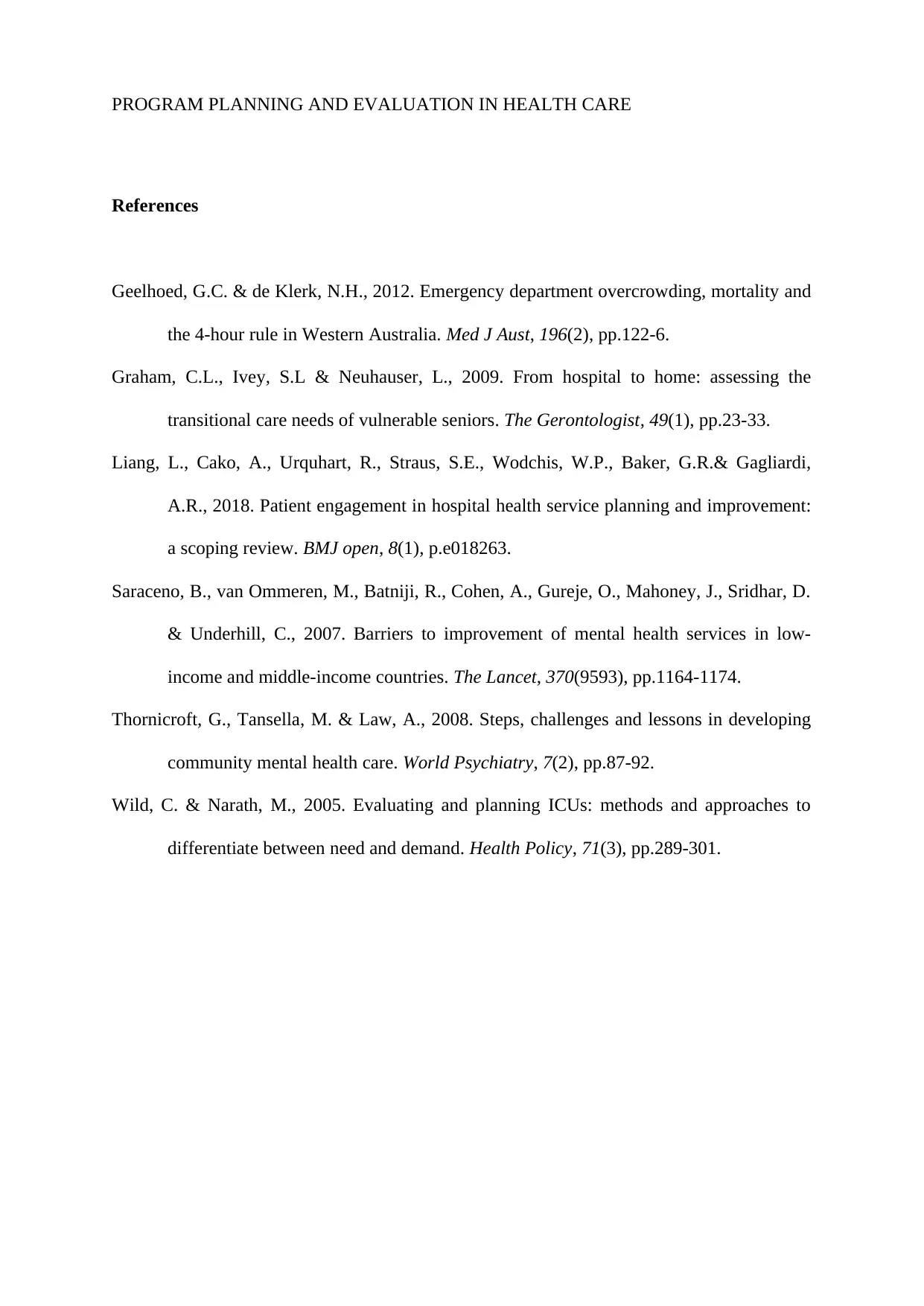
PROGRAM PLANNING AND EVALUATION IN HEALTH CARE
References
Geelhoed, G.C. & de Klerk, N.H., 2012. Emergency department overcrowding, mortality and
the 4-hour rule in Western Australia. Med J Aust, 196(2), pp.122-6.
Graham, C.L., Ivey, S.L & Neuhauser, L., 2009. From hospital to home: assessing the
transitional care needs of vulnerable seniors. The Gerontologist, 49(1), pp.23-33.
Liang, L., Cako, A., Urquhart, R., Straus, S.E., Wodchis, W.P., Baker, G.R.& Gagliardi,
A.R., 2018. Patient engagement in hospital health service planning and improvement:
a scoping review. BMJ open, 8(1), p.e018263.
Saraceno, B., van Ommeren, M., Batniji, R., Cohen, A., Gureje, O., Mahoney, J., Sridhar, D.
& Underhill, C., 2007. Barriers to improvement of mental health services in low-
income and middle-income countries. The Lancet, 370(9593), pp.1164-1174.
Thornicroft, G., Tansella, M. & Law, A., 2008. Steps, challenges and lessons in developing
community mental health care. World Psychiatry, 7(2), pp.87-92.
Wild, C. & Narath, M., 2005. Evaluating and planning ICUs: methods and approaches to
differentiate between need and demand. Health Policy, 71(3), pp.289-301.
References
Geelhoed, G.C. & de Klerk, N.H., 2012. Emergency department overcrowding, mortality and
the 4-hour rule in Western Australia. Med J Aust, 196(2), pp.122-6.
Graham, C.L., Ivey, S.L & Neuhauser, L., 2009. From hospital to home: assessing the
transitional care needs of vulnerable seniors. The Gerontologist, 49(1), pp.23-33.
Liang, L., Cako, A., Urquhart, R., Straus, S.E., Wodchis, W.P., Baker, G.R.& Gagliardi,
A.R., 2018. Patient engagement in hospital health service planning and improvement:
a scoping review. BMJ open, 8(1), p.e018263.
Saraceno, B., van Ommeren, M., Batniji, R., Cohen, A., Gureje, O., Mahoney, J., Sridhar, D.
& Underhill, C., 2007. Barriers to improvement of mental health services in low-
income and middle-income countries. The Lancet, 370(9593), pp.1164-1174.
Thornicroft, G., Tansella, M. & Law, A., 2008. Steps, challenges and lessons in developing
community mental health care. World Psychiatry, 7(2), pp.87-92.
Wild, C. & Narath, M., 2005. Evaluating and planning ICUs: methods and approaches to
differentiate between need and demand. Health Policy, 71(3), pp.289-301.
1 out of 10
Your All-in-One AI-Powered Toolkit for Academic Success.
+13062052269
info@desklib.com
Available 24*7 on WhatsApp / Email
![[object Object]](/_next/static/media/star-bottom.7253800d.svg)
Unlock your academic potential
Copyright © 2020–2025 A2Z Services. All Rights Reserved. Developed and managed by ZUCOL.

